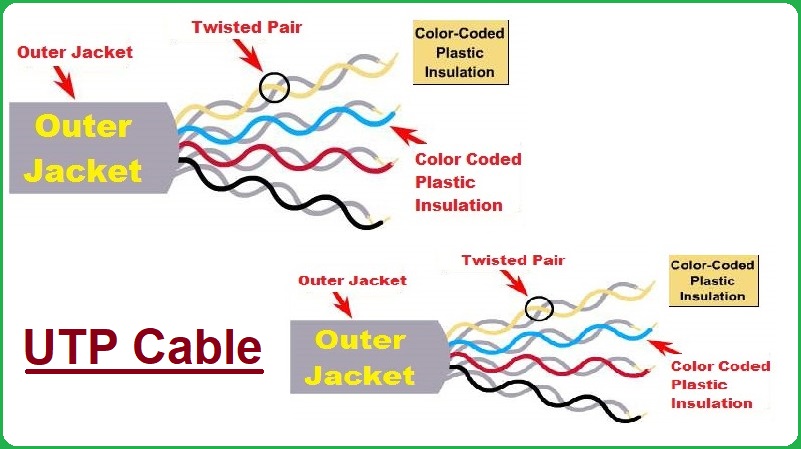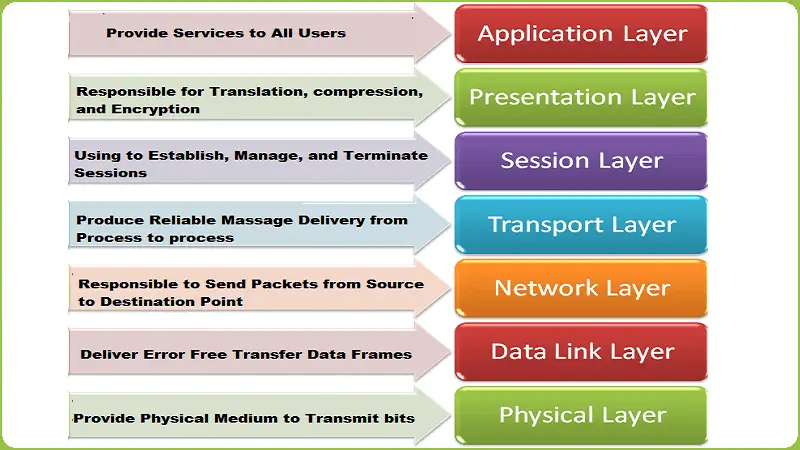What is UTP Cable in Networking?
Definition: UTP stands for “Unshielded Twisted Pair” cable, and it contains 100 ohm copper cable that has 2 to 1800 unshielded twisted pairs surrounded by an outer jacket. It has no any metallic shield, and helps to make small in diameter but does not provide better protection appose to electrical interference.
How does UTP work: UTP cable has four pair of color coded copper wires together that covered with flexible plastic sheath. Due to twist of copper wire, it gets cancel electromagnetic interference from the external sources.

Unshielded twisted pair cable does not contain any other extra shielding such as meshes or aluminum foil, which appended in bulk, are using. UTP cables do not implement any shielding to counter EMI and RFI effects.
UTP cables are mostly using in the computer network as well as in the telecommunication sector as telephone wires and Ethernet cables. It is small size, so easy to installation.
Types of UTP Cables
Unshielded twisted pair has fives categories that defined by TIA/EIA 568 standard; below mention each one –

CAT1: CAT1 only uses in telephone wiring, but it is not able to support computer network traffic and is not get twist.
CAT2: CAT2 is commonly using for token ring networks,, and it can support up to 4 Mbps transfer data speed.
CAT3: At present days, CAT3 is also commonly using in phone lines, and it can support 10 Mbps for up to 100 meters.
CAT4: CAT4 is designed especially for token ring networks and other networking system, because it is capable to support 16 Mbps for up to 100 meters.
CAT5: It is mostly going to use in Ethernet based LANs networks, and it consists four twisted pairs, as well as having ability to 100 Mbps for up to 100 meters.
CAT5e: CAT5e is a sub type of CAT5, so it can also use in Ethernet based LANs networks. It contains four twisted pairs, and can support 1 Gbps for 100 meters.
CAT6: CAT6 introduced to support gigabit Ethernet that allows gigabit transmission over CAT5e cable. It consists physical separator in between four pair that helps to decrease electromagnetic interference.
CAT6e: CAT6 has four tightly wounded twisted pairs, and it mostly uses in Ethernet-based LANs and data center networks. I can support 1 Gbps for up to 100 meters and 10 Gbps for up to 50 meters.
CAT7: CAT7 contains 4 individually shielded pair plus an extra cable shield to provide the protection the signals from crosstalk and electromagnetic interference, and it can support 10Gbps at lengths of up to 100 meters.
Uses and Applications of UTP Cable
- Unshielded twisted pair cable has mostly application areas LAN networks, and it also can use low speed data, voice, audio and paging systems, high speed data, as well as building automation and control systems.
- Unshielded twisted pair cable is also commonly using in horizontal and backbone cabling subsystems.
- It also uses in computer and telecommunications industry as Ethernet cables and telephone wires.
Advantages of UTP Cable
There are various benefits of unshielded twisted pair cable; below explain each one –
- It has great flexibility that helps to make easier to installation and handling.
- Affordable price than other networking cables
- It takes less space, due to small size so it doesn’t need fill up wiring ducts.
- Mostly used for networking architecture
- UTP cable introduces to encounter to EMI, RFI and crosstalk.
- In UTP cable, doesn’t need grounding.
Disadvantages of UTP Cable
There are various limitations of unshielded twisted pair cable; below explain each one –
- UTP is limited to bandwidth.
- It is not able to provide better protection in transmission of data.
- UTP is capable only to cable segment length about 100 meters only.
- It gets susceptible to noise and highly prone to external interference such as EMI and RFI.
- UTP gets more susceptible to interference than other kinds of cables.
- UTP cable contains the signal boosts in shorter compare to other cables like as coaxial cable and fiber optic cables and shielded twisted pair cable.
Characteristics of UTP Cable
- It provides the speed or throughput of almost 10 to 1000Mbps.
- It contains the maximum cable length of about 100 meter.
- UTP gets high attenuation than STP.
- It generates higher crosstalk to STP.
- It does not need grounding cable.



